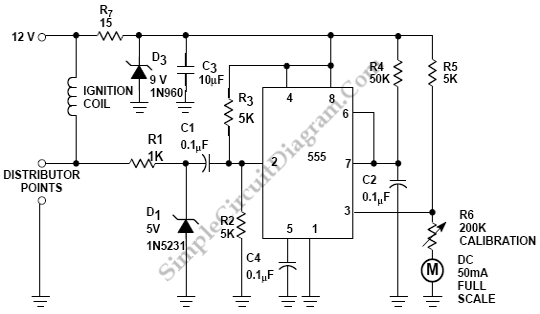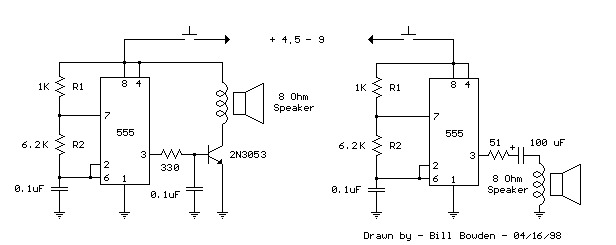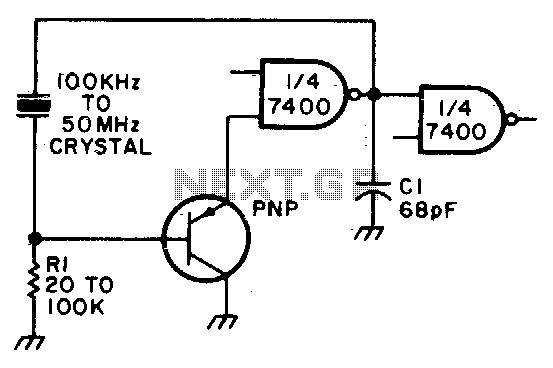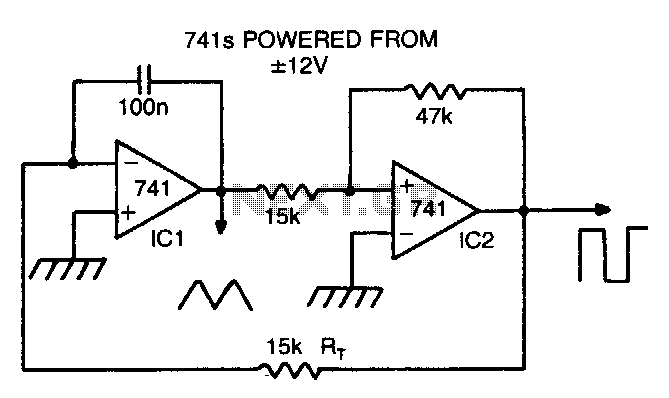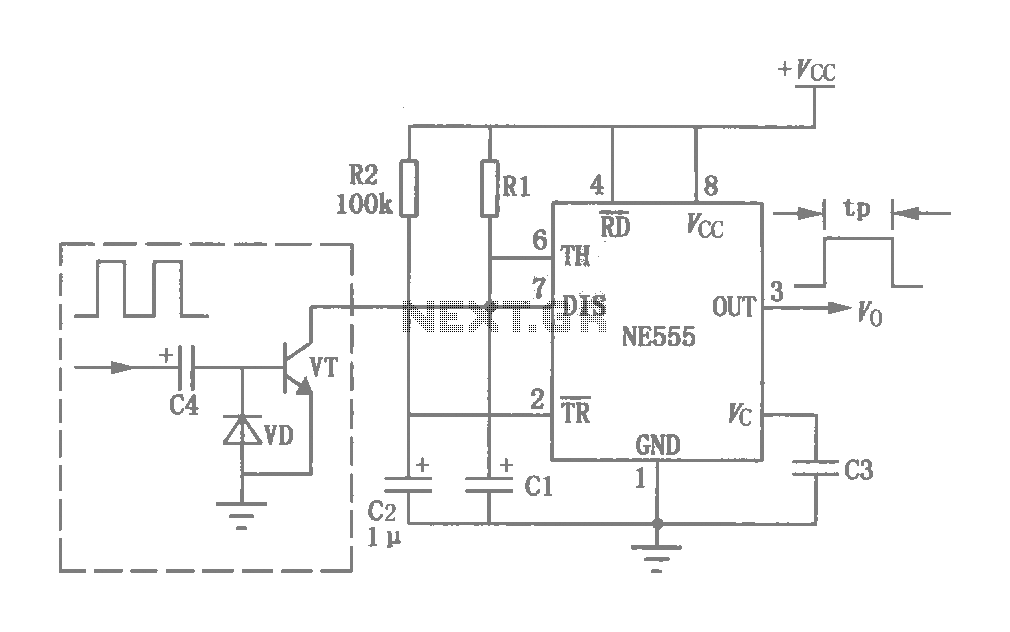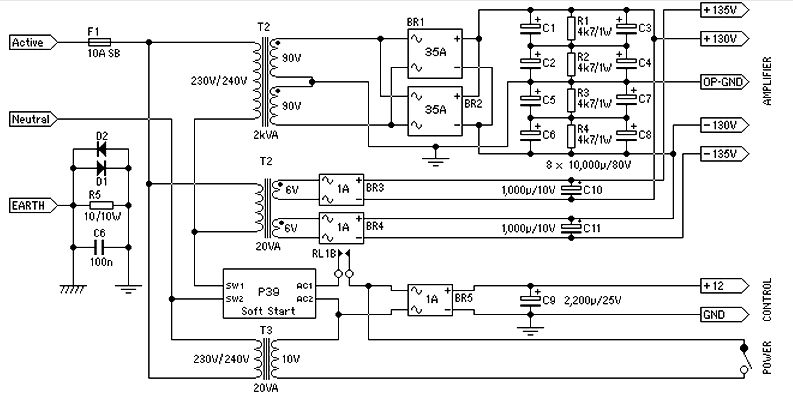
555 audio oscillator
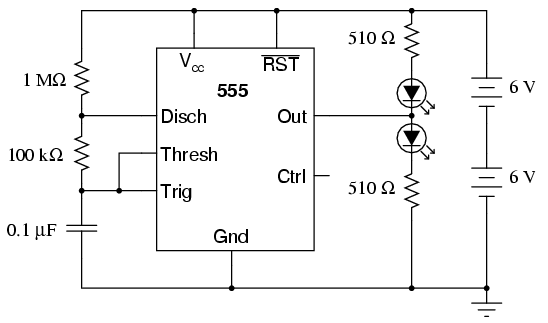
An oscilloscope is useful for analyzing the waveforms produced by this circuit, although it is not essential. An audio detector serves as a valuable piece of test equipment for this experiment, particularly if an oscilloscope is unavailable. The "555" integrated circuit is a general-purpose timer that can perform various functions. In this experiment, its application as an astable multivibrator, or oscillator, is explored. When connected to a capacitor and two resistors as illustrated, it will oscillate freely, turning the LEDs on and off with a square-wave output voltage. The circuit operates by alternately charging and discharging a capacitor. The 555 timer discharges the capacitor by grounding the Disch terminal when the voltage at the Thresh terminal exceeds 2/3 of the power supply voltage (Vcc). Discharging stops when the voltage at the Trig terminal drops below 1/3 of the power supply voltage. Consequently, with both Thresh and Trig terminals connected to the positive terminal of the capacitor, the capacitor voltage cycles between 1/3 and 2/3 of the power supply voltage in a "sawtooth" pattern. During the charging cycle, the capacitor receives current through the series arrangement of a 1 MΩ and a 100 kΩ resistor. When the Disch terminal of the 555 timer goes to ground potential (due to a transistor inside the 555 being activated), the capacitor's discharging current flows only through the 100 kΩ resistor. This configuration results in a longer RC time constant for charging compared to discharging, leading to a charging time that significantly exceeds the discharging time. The Out terminal of the 555 timer generates a square-wave voltage signal that is "high" (close to Vcc) during the capacitor's charging phase and "low" (close to 0 volts) during discharging. This alternating high/low voltage signal drives the two LEDs in opposite states: when one LED is illuminated, the other is off. Due to the unequal charging and discharging times, the "high" and "low" durations of the output square-wave signal will also be unequal. This difference can be observed in the relative brightness of the two LEDs: one will appear much brighter than the other because it remains on for a longer duration in each cycle. The relationship between the "high" and "low" durations of a square wave is quantified as its duty cycle. A square wave with a 50% duty cycle is perfectly symmetrical, with "high" and "low" durations being equal. Conversely, a square wave that is "high" 10% of the time and "low" 90% of the time is characterized by a 10% duty cycle. In this circuit, the output waveform exhibits a "high" duration that exceeds the "low" duration, resulting in a duty cycle greater than 50%. The audio detector (or oscilloscope) can be employed to examine the various voltage waveforms produced by this circuit. Experimenting with different resistor and capacitor values will reveal their effects on output frequency and charge/discharge times.
The described circuit involves a 555 timer configured as an astable multivibrator, which is a fundamental application of the IC. The 555 timer operates in an astable mode by continuously switching between its high and low states without requiring external triggering. The timing components, specifically the resistors and capacitor, dictate the frequency of oscillation and the duty cycle of the output waveform.
In this configuration, the two resistors (1 MΩ and 100 kΩ) and the capacitor form an RC timing network that determines how fast the capacitor charges and discharges. The charging time (T_high) can be calculated using the formula:
\[ T_{high} = 0.693 \times (R_1 + R_2) \times C \]
where \( R_1 \) is 1 MΩ, \( R_2 \) is 100 kΩ, and \( C \) is the capacitance in farads. The discharging time (T_low) is given by:
\[ T_{low} = 0.693 \times R_2 \times C \]
The total period (T) of the output waveform is the sum of T_high and T_low:
\[ T = T_{high} + T_{low} \]
The frequency (f) can then be derived from the total period:
\[ f = \frac{1}{T} \]
This relationship indicates that adjusting either the resistor or capacitor values will directly influence the frequency of the output square wave. The duty cycle can also be calculated as:
\[ Duty\ Cycle = \frac{T_{high}}{T} \times 100\% \]
By experimenting with different resistor and capacitor values, one can observe the changes in frequency and duty cycle, which can be visually represented through the brightness of the LEDs. The circuit provides a practical demonstration of the 555 timer's capabilities, illustrating fundamental concepts of timing, waveform generation, and the relationship between charge and discharge in capacitive circuits.A oscilloscope would be useful in analyzing the waveforms produced by this circuit, but it is not essential. An audio detector is a very useful piece of test equipment for this experiment, especially if you don`t have an oscilloscope.
The "555" integrated circuit is a general-purpose timer useful for a variety of functions. In this experiment, we explore its use as an astable multivibrator, or oscillator. Connected to a capacitor and two resistors as shown, it will oscillate freely, driving the LEDs on and off with a square-wave output voltage. This circuit works on the principle of alternately charging and discharging a capacitor. The 555 begins to discharge the capacitor by grounding the Disch terminal when the voltage detected by the Thresh terminal exceeds 2/3 the power supply voltage (Vcc).
It stops discharging the capacitor when the voltage detected by the Trig terminal falls below 1/3 the power supply voltage. Thus, when both Thresh and Trig terminals are connected to the capacitor`s positive terminal, the capacitor voltage will cycle between 1/3 and 2/3 power supply voltage in a "sawtooth" pattern.
During the charging cycle, the capacitor receives charging current through the series combination of the 1 M © and 100 k © resistors. As soon as the Disch terminal on the 555 timer goes to ground potential (a transistor inside the 555 connected between that terminal and ground turns on), the capacitor`s discharging current only has to go through the 100 k © resistor.
The result is an RC time constant that is much longer for charging than for discharging, resulting in a charging time greatly exceeding the discharging time. The 555`s Out terminal produces a square-wave voltage signal that is "high" (nearly Vcc) when the capacitor is charging, and "low" (nearly 0 volts) when the capacitor is discharging.
This alternating high/low voltage signal drives the two LEDs in opposite modes: when one is on, the other will be off. Because the capacitor`s charging and discharging times are unequal, the "high" and "low" times of the output`s square-wave waveform will be unequal as well.
This can be seen in the relative brightness of the two LEDs: one will be much brighter than the other, because it is on for a longer period of time during each cycle. The equality or inequality between "high" and "low" times of a square wave is expressed as that wave`s duty cycle.
A square wave with a 50% duty cycle is perfectly symmetrical: its "high" time is precisely equal to its "low" time. A square wave that is "high" 10% of the time and "low" 90% of the time is said to have a 10% duty cycle.
In this circuit, the output waveform has a "high" time exceeding the "low" time, resulting in a duty cycle greater than 50%. Use the audio detector (or an oscilloscope) to investigate the different voltage waveforms produced by this circuit.
Try different resistor values and/or capacitor values to see what effects they have on output frequency or charge/discharge times. 🔗 External reference
The described circuit involves a 555 timer configured as an astable multivibrator, which is a fundamental application of the IC. The 555 timer operates in an astable mode by continuously switching between its high and low states without requiring external triggering. The timing components, specifically the resistors and capacitor, dictate the frequency of oscillation and the duty cycle of the output waveform.
In this configuration, the two resistors (1 MΩ and 100 kΩ) and the capacitor form an RC timing network that determines how fast the capacitor charges and discharges. The charging time (T_high) can be calculated using the formula:
\[ T_{high} = 0.693 \times (R_1 + R_2) \times C \]
where \( R_1 \) is 1 MΩ, \( R_2 \) is 100 kΩ, and \( C \) is the capacitance in farads. The discharging time (T_low) is given by:
\[ T_{low} = 0.693 \times R_2 \times C \]
The total period (T) of the output waveform is the sum of T_high and T_low:
\[ T = T_{high} + T_{low} \]
The frequency (f) can then be derived from the total period:
\[ f = \frac{1}{T} \]
This relationship indicates that adjusting either the resistor or capacitor values will directly influence the frequency of the output square wave. The duty cycle can also be calculated as:
\[ Duty\ Cycle = \frac{T_{high}}{T} \times 100\% \]
By experimenting with different resistor and capacitor values, one can observe the changes in frequency and duty cycle, which can be visually represented through the brightness of the LEDs. The circuit provides a practical demonstration of the 555 timer's capabilities, illustrating fundamental concepts of timing, waveform generation, and the relationship between charge and discharge in capacitive circuits.A oscilloscope would be useful in analyzing the waveforms produced by this circuit, but it is not essential. An audio detector is a very useful piece of test equipment for this experiment, especially if you don`t have an oscilloscope.
The "555" integrated circuit is a general-purpose timer useful for a variety of functions. In this experiment, we explore its use as an astable multivibrator, or oscillator. Connected to a capacitor and two resistors as shown, it will oscillate freely, driving the LEDs on and off with a square-wave output voltage. This circuit works on the principle of alternately charging and discharging a capacitor. The 555 begins to discharge the capacitor by grounding the Disch terminal when the voltage detected by the Thresh terminal exceeds 2/3 the power supply voltage (Vcc).
It stops discharging the capacitor when the voltage detected by the Trig terminal falls below 1/3 the power supply voltage. Thus, when both Thresh and Trig terminals are connected to the capacitor`s positive terminal, the capacitor voltage will cycle between 1/3 and 2/3 power supply voltage in a "sawtooth" pattern.
During the charging cycle, the capacitor receives charging current through the series combination of the 1 M © and 100 k © resistors. As soon as the Disch terminal on the 555 timer goes to ground potential (a transistor inside the 555 connected between that terminal and ground turns on), the capacitor`s discharging current only has to go through the 100 k © resistor.
The result is an RC time constant that is much longer for charging than for discharging, resulting in a charging time greatly exceeding the discharging time. The 555`s Out terminal produces a square-wave voltage signal that is "high" (nearly Vcc) when the capacitor is charging, and "low" (nearly 0 volts) when the capacitor is discharging.
This alternating high/low voltage signal drives the two LEDs in opposite modes: when one is on, the other will be off. Because the capacitor`s charging and discharging times are unequal, the "high" and "low" times of the output`s square-wave waveform will be unequal as well.
This can be seen in the relative brightness of the two LEDs: one will be much brighter than the other, because it is on for a longer period of time during each cycle. The equality or inequality between "high" and "low" times of a square wave is expressed as that wave`s duty cycle.
A square wave with a 50% duty cycle is perfectly symmetrical: its "high" time is precisely equal to its "low" time. A square wave that is "high" 10% of the time and "low" 90% of the time is said to have a 10% duty cycle.
In this circuit, the output waveform has a "high" time exceeding the "low" time, resulting in a duty cycle greater than 50%. Use the audio detector (or an oscilloscope) to investigate the different voltage waveforms produced by this circuit.
Try different resistor values and/or capacitor values to see what effects they have on output frequency or charge/discharge times. 🔗 External reference
